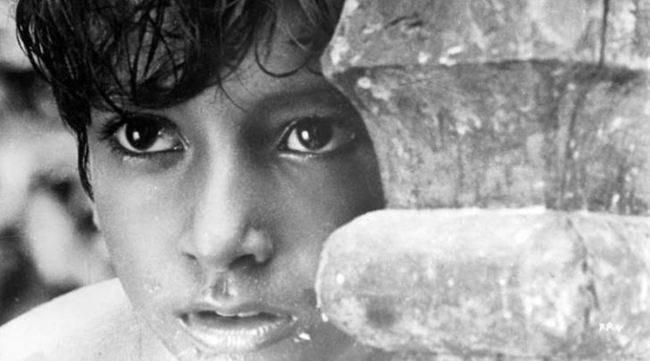Opinion 70 years on, what makes ‘Pather Panchali’ endure — across cultures and time
It is a living text that continues to question us: What stories are we telling today, and to whom? Are we still willing to look at ordinary lives with dignity?
 The thrill of discovery when Apu sees the train is the thrill of every child encountering the vastness of the world.
The thrill of discovery when Apu sees the train is the thrill of every child encountering the vastness of the world. By Vani Tripathi Tikoo
When Pather Panchali premiered at Cannes in 1956, it altered the world’s image of Indian cinema forever. Until then, the international imagination saw Indian films as song-drenched spectacles, exotic and melodramatic. Satyajit Ray’s debut brought something radically different: A quiet, luminous portrait of a poor family in rural Bengal, where children chased trains through mustard fields and mothers bore the weight of survival with a mixture of bitterness and grace. The world discovered that India could tell its stories not only in colour and glamour, but also in the muted shades of truth.
Nearly seven decades later, Pather Panchali continues to astonish — not as a museum artifact or a cinephile’s fetish, but as a film that speaks across cultures and time. Its enduring power lies in the fact that it is not “about” poverty, or even about rural Bengal. It is about life itself, captured with honesty and compassion.
Ordinary lives, extraordinary poetry
Adapted from Bibhutibhushan Bandopadhyay’s 1929 novel, the film follows a poor Brahmin family: Harihar, the father, is a dreamer forever on the move in search of work; Sarbajaya, the mother, is weary yet resilient, torn between anger and love; Durga, the mischievous elder daughter, is full of tenderness and defiance; and Apu, the younger son, wide-eyed and curious, is just beginning to discover the world.
Their struggles are familiar — unpaid debts, food scarcity, illness without medical care. And yet, Ray transforms these struggles into luminous fragments of cinema.
Consider the sequence where Apu and Durga run through tall grass to glimpse a train slicing through the horizon. It is cinema’s purest articulation of wonder — the pull of the unknown, the recognition that the world is larger than the village road. Or take the scene of Sarbajaya scolding Durga for stealing guavas. In a single breath, Karuna Banerjee’s face flickers between shame, anger and helpless love. This is not melodrama; it is life unfolding, tender and raw.
The frail old aunt Indir Thakrun, played by 83-year-old Chunibala Devi, is another unforgettable presence. She shuffles through the household, half-dependent, half-independent, a living symbol of time’s passage. Her death is filmed without spectacle — only a quiet absence that leaves the family hollow.
Born of struggle, destined for immortality
The making of Pather Panchali is itself a story of resilience. Ray, then a young advertising executive and illustrator, shot the film intermittently over three years. Funds ran out so often that he had to pawn his wife’s jewellery. The West Bengal government eventually stepped in with support.
His crew was young and largely inexperienced. Cinematographer Subrata Mitra was just 21, experimenting with natural light and inventing “bounce lighting” to soften shadows. The music was composed by Ravi Shankar in an all-night session. Out of these limitations emerged a work of startling originality.
When the film travelled abroad, it was hailed as a revelation. At Cannes, it won the “Best Human Document” award. Critics compared Ray to Vittorio De Sica and Jean Renoir, but it soon became clear that his voice was uniquely his own. Indian cinema had found not just a new director, but an auteur who would place it firmly on the world map.
A cinema of compassion
What makes Pather Panchali endure is its compassion. Ray never romanticises poverty, nor does he exploit it for sentiment. Instead, he looks at his characters with tenderness and dignity. Their joys are fleeting, their losses devastating, yet their lives are never reduced to mere symbols.
Even today, audiences recognise themselves in its moments. The thrill of discovery when Apu sees the train is the thrill of every child encountering the vastness of the world. The sudden death of Durga echoes our first childhood grief. Sarbajaya’s resilience — gathering the family to leave their ancestral home after unbearable losses — is the story of countless mothers everywhere.
The road today
Why revisit Pather Panchali now? In an age of hyper-edited spectacles and noisy box-office wars, Ray’s film is a reminder of cinema’s quieter possibilities. At a time when Indian films are again being celebrated globally — whether it is Payal Kapadia’s All We Imagine As Light winning at Cannes or RRR storming the Oscars — it is worth remembering that this journey began with a little road in Bengal. Ray showed the world that authenticity, honesty and compassion could travel farther than spectacle.
Pather Panchali is not simply a classic to be preserved. It is a living text that continues to question us: What stories are we telling today, and to whom? Are we still willing to look at ordinary lives with dignity, or are we content with noise and distraction?
The song of the little road still echoes. The train will always pass, the children will always run, and the mother will always watch in silence. That road still winds through time, carrying the echo of footsteps — Apu’s, Durga’s, and perhaps our own.
The writer is a theatre actor, filmmaker and film producer




